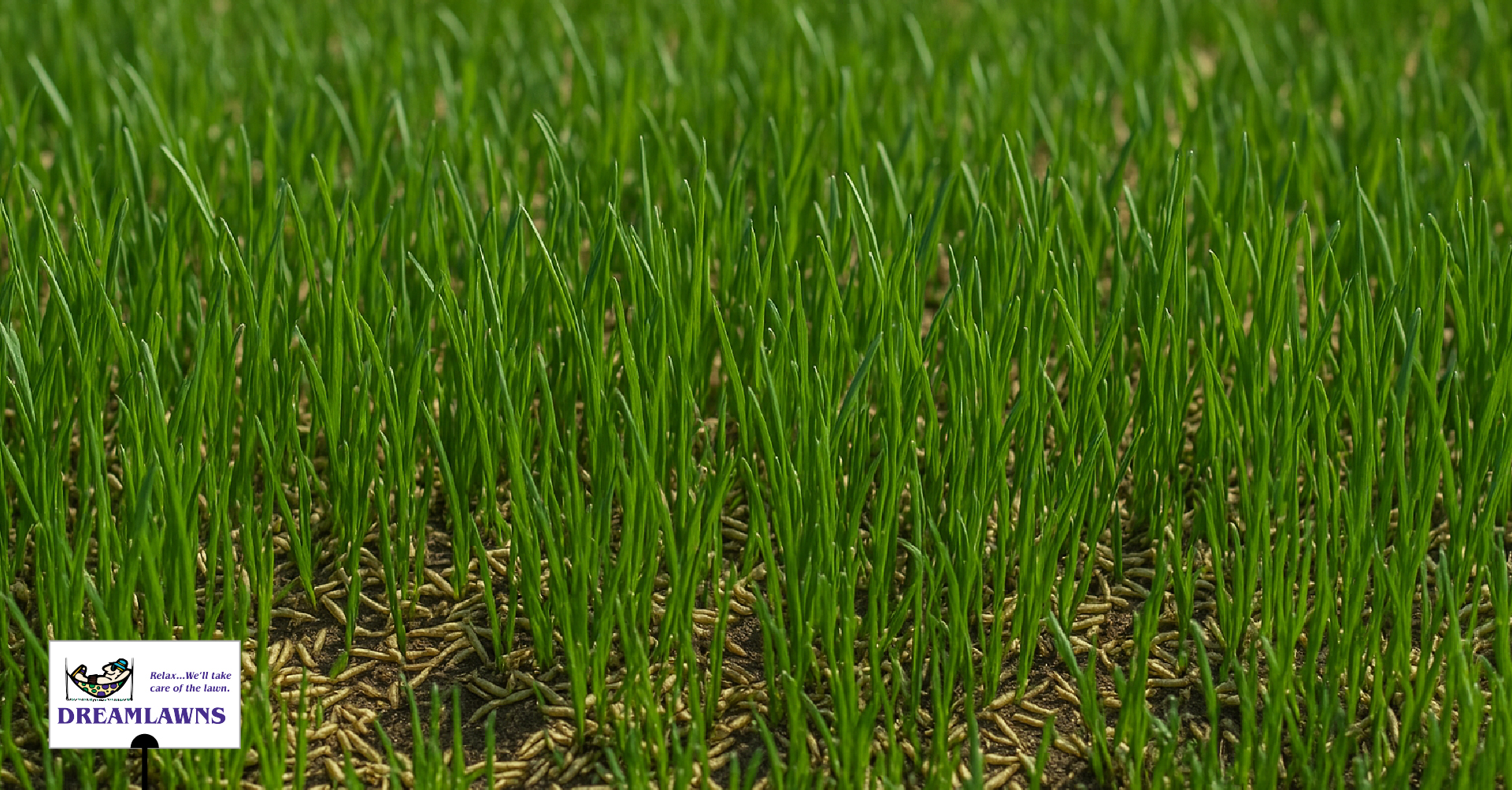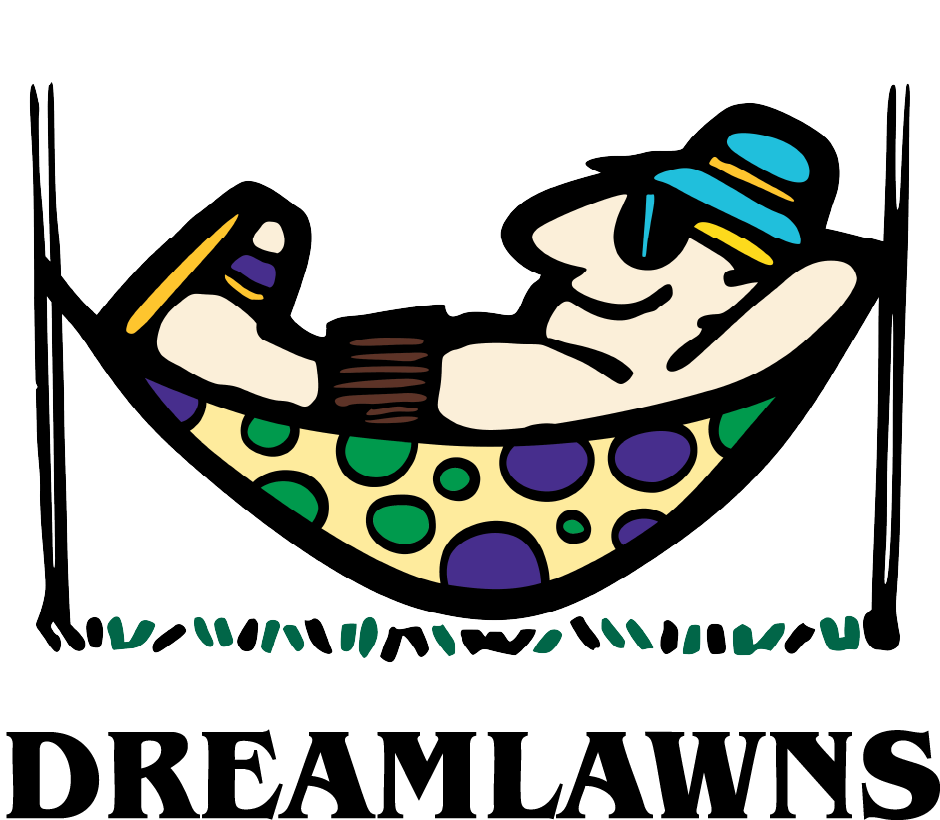
Dreamlawns Quick Cut: For Virginia Beach lawns, especially Fescue, overseeding isn’t optional, it’s essential. Heat, drought, disease, and compacted soil naturally thin cool-season grass each year. Overseeding every fall restores turf density, improves color, and keeps your lawn healthy through the seasons. Pairing aeration with overseeding ensures new seed makes contact with the soil and roots deeply.
If you own a Fescue lawn in Virginia Beach, chances are you’ve looked out at your yard in late summer and thought, “Didn’t this look a lot better in the spring?” You’re not alone, and you’re not imagining it.
Fescue is a cool-season grass, which means it thrives in the mild temperatures of spring and fall but struggles during the hot, humid summers our area is known for. Between drought stress, compacted soil, disease pressure, and heavy foot traffic, your lawn takes a beating. And unlike some warm-season grasses, Fescue doesn’t spread to fill in damaged areas on its own.
That’s why overseeding isn’t just a nice-to-have, it’s a must-do. Each fall, overseeding with high-quality seed helps rebuild turf density, repair summer thinning, and ensure your lawn comes back strong and healthy.
Why Fescue Lawns Thin Each Year, and What You Can Do About It
Fescue is popular in Virginia Beach because it stays green year-round and handles cool weather beautifully. But it has one major limitation, it doesn’t spread. Unlike warm-season grasses like Bermuda or Zoysia, Fescue won’t fill in bare spots on its own. When it thins out, it stays thin until you take action. That thinning is a natural part of the turf’s life cycle, and it’s made worse by a few unavoidable seasonal stressors:
Summer Heat and Drought
Fescue struggles once temperatures rise above 85°F. Long stretches of dry weather or inconsistent irrigation can quickly lead to browning, thinning, and root die-off.
Fungal Disease Pressure
Virginia Beach’s humidity creates perfect conditions for diseases like Brown Patch and Gray Leaf Spot to flourish during the summer. These diseases can destroy turf in large sections, especially if the lawn is already under stress.
Soil Compaction
Lawns that get walked on frequently or that see a lot of activity during the summer develop compacted soils. Compacted soil suffocates roots by blocking air, water, and nutrients. This not only weakens the existing turf but also prevents new grass from growing in.
Foot Traffic and Wear
Whether it’s backyard barbecues, kids playing, or pets running around, regular summer use takes a toll on turf. The more wear your lawn experiences, the more it thins out by fall.
All of this means that by the time September rolls around, most Fescue lawns are tired, patchy, and in need of repair. That’s where overseeding comes in, it’s your opportunity to refresh the turf, rebuild density, and get ahead of next year’s stress.
When and How to Seed for Best Results
If you’re wondering when to seed your lawn, the answer is simple: fall is the best time to overseed Fescue in Virginia Beach. From late September through early November, conditions are ideal for seed germination and root establishment.
Cooler air temperatures take stress off young grass, while the soil still holds warmth from summer, creating the perfect window for strong root growth before winter. Add in the typically higher fall rainfall, and you’ve got the most forgiving and effective time of year to overseed. But timing alone isn’t enough, you also need to seed the right way to get results that last.
Here’s the best way to plant grass seed for long-term success:
Start with Aeration
Compacted soils are one of the biggest reasons Fescue thins out. Core aeration opens up the soil, improving air, water, and nutrient flow while creating ideal pockets for seed to settle in. This step is crucial if you want the seed to actually take root.
Choose the Right Seed
Not all seed is created equal. Using high-quality, region-appropriate seed makes a big difference in how well your lawn bounces back.
Ensure Good Seed-to-Soil Contact
After seeding, lightly rake the area or use a roller to press the seed into the soil. Grass seed can’t grow if it’s just sitting on top of thatch or debris.
Water Lightly and Often
Keep the seeded areas moist but not soaked until germination. This usually means watering lightly once or twice a day for the first 2–3 weeks. Once the seedlings are established, you can taper back to a deeper, less frequent schedule.
Pair with Fall Fertilization
Overseeding works best when combined with fall fertilization. At Dreamlawns, we apply about 70% of your lawn’s annual nitrogen during the fall months to support strong root development and give new grass a head start.
By overseeding at the right time and with the right techniques, you’ll restore turf density, improve color, and set the stage for a much healthier lawn next spring.
Not All Grass Seed Is Created Equal
If you’ve ever walked down the seed aisle at a big box store, you’ve probably seen bags with flashy labels claiming quick germination and lush growth. But here’s the truth: most retail grass seed mixes contain a high percentage of filler, outdated seed, or varieties that simply don’t perform well in the Virginia Beach climate.
When it comes to overseeding, seed quality matters just as much as timing and technique. Choosing the wrong seed can lead to weak germination, poor disease resistance, and patchy results, even if you do everything else right.
At Dreamlawns, we recommend and use Aqua Maxx tall fescue, a high-performance seed blend developed specifically for our region. It’s drought-tolerant, disease-resistant, and has excellent color retention, especially during Virginia’s hot summers.
Here’s why premium seed makes a difference:
- Better Germination Rates: High-quality seed has a higher percentage of live seed and fewer inert ingredients, so more of what you put down actually grows.
- Stronger, Deeper Roots: Quality seed produces grass with more robust root systems, helping your lawn resist drought and recover from damage faster.
- Improved Disease Resistance: Inferior seed varieties are more susceptible to Brown Patch, Gray Leaf Spot, and other turf diseases common in the Tidewater area.
- Uniform Appearance: A good seed blend results in a more consistent, attractive lawn. No clumps, color differences, or uneven growth.
Whether you’re overseeding a few patches or the entire yard, investing in the right seed is the foundation of a successful lawn renovation. And with Dreamlawns, you never have to wonder what’s in the bag, we only use turf varieties we’ve tested and trust.
What Happens If You Skip Overseeding?
Overseeding may not feel urgent when your lawn looks “okay”, but skipping it even once can start a slow decline that’s hard to reverse. Because Fescue doesn’t spread, any thinning caused by summer stress, disease, or soil compaction will stay thin unless new seed is introduced. And a thin lawn isn’t just a cosmetic issue, it creates an open invitation for bigger problems.
Here’s what can happen when you skip overseeding:
Weeds Move In
Bare spots and thin turf make it easier for aggressive weeds like crabgrass, clover, and dandelions to take hold. Once weeds establish themselves, they outcompete healthy grass for water, nutrients, and sunlight.
Disease Becomes More Severe
Thinner lawns are more susceptible to fungal diseases like Brown Patch, since there’s less healthy turf to buffer against outbreaks. Weak turf also struggles to recover from damage.
Soil Compaction Gets Worse
With fewer roots holding it together, compacted soil becomes harder for water and air to penetrate. This chokes out what grass remains and makes it even harder for new grass to grow next season.
Your Lawn Starts to Spiral
Once thinning begins, each year gets a little worse, less turf, more weeds, and lower curb appeal. Eventually, you may find yourself needing a full renovation rather than a simple overseeding.
The good news? Overseeding each fall helps you avoid this cycle entirely. By thickening your lawn every year, you prevent weeds, crowd out disease, and build a lawn that’s resilient to whatever the next season brings.
Dreamlawns Makes It Easy
If you’re searching for lawn seeding near me and want more than just a seasonal quick fix, Dreamlawns offers a smarter, long-term solution. Our professional overseeding service is part of a year-round lawn care program that’s tailored to your lawn’s unique conditions, seasonal stressors, and goals.
We don’t take a one-size-fits-all approach. Instead, we time your overseeding based on turf type, local weather, and upcoming seasonal needs. Each application is coordinated with aeration to relieve compaction and improve seed-to-soil contact, and we pair it with high-nitrogen fall fertilization, providing about 70% of your lawn’s yearly nitrogen during peak root-building months. This results in deeper roots, better germination, and healthier turf going into winter.
If your lawn feels like it’s just barely hanging on by the end of summer, you’re not alone, and you’re not out of options. Our fall overseeding services restore thickness, improve color, and help your turf compete with weeds and disease year after year.
Ready to Restore Your Lawn?
Overseeding isn’t just a seasonal suggestion, it’s a necessity for maintaining a thick, healthy Fescue lawn in Virginia Beach. From summer heat and drought to disease and soil compaction, your lawn faces real challenges every year. Overseeding each fall helps you stay ahead of those issues by rebuilding turf density, strengthening roots, and improving your lawn’s ability to resist weeds and recover from stress.
At Dreamlawns, we make the process simple. Our expert team handles the timing, aeration, seed selection, and fertilization so you get professional results without the guesswork. Whether you’re dealing with thinning turf or just want to keep your lawn looking its best, we’ll create a tailored plan that delivers long-term results.
Don’t wait until bare spots and weeds take over. Contact us today to schedule your fall overseeding service and give your lawn the fresh start it needs.
Dreamlawns provides superior lawn care service to Virginia Beach & Chesapeake VA residents.




